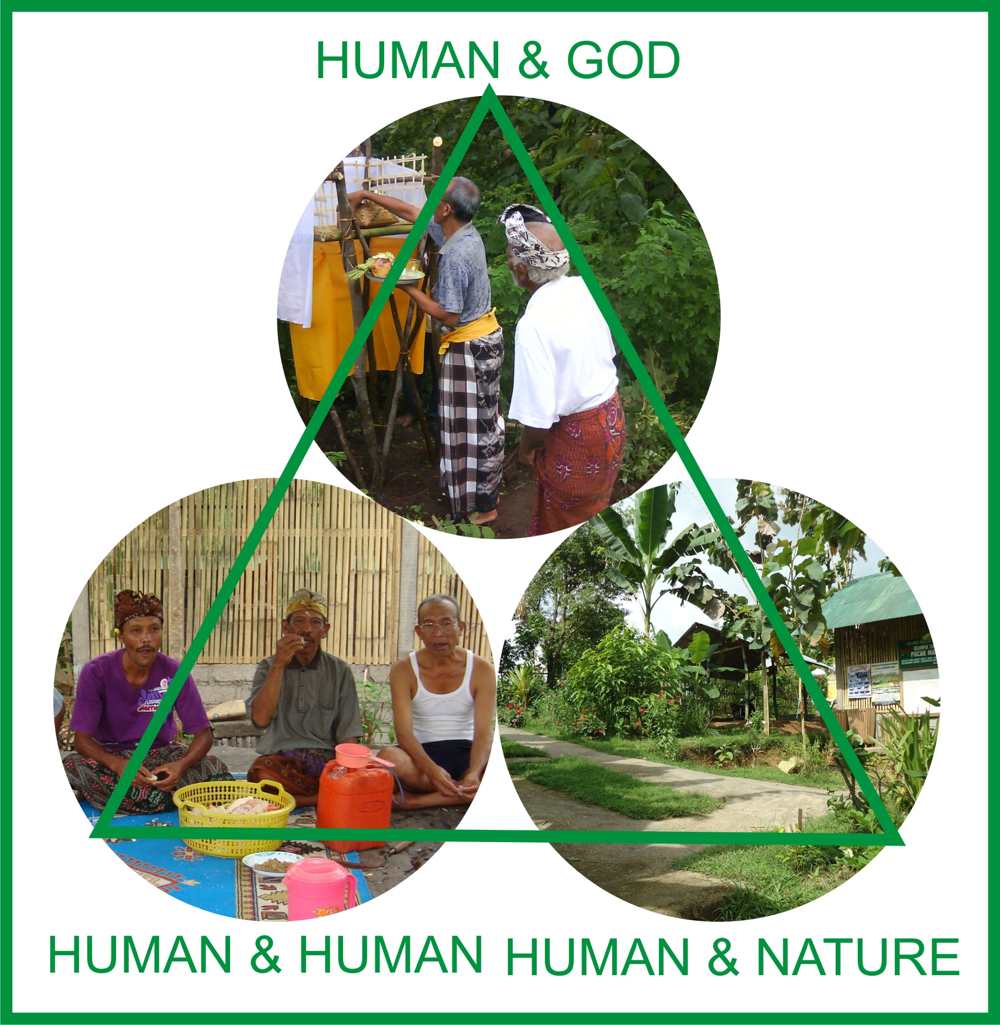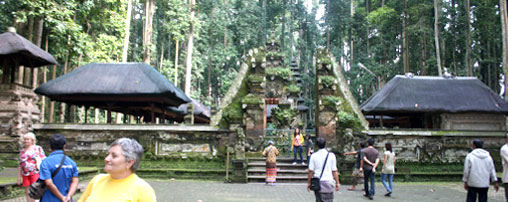A. Definition
Tri Hita Karana, is derived from the Sanskrit language. From the word Tri meaning three, Hita Karana means prosperous and meaningful causes. Tri Hita Karana is understanding the three main things that led to the welfare and prosperity of human life, that has meaning to keep the harmony and balance between human to God, human-to-human and human to environment.
These three concepts is most popular in Bali spread out as Parhyangan, Palemahan, and Pawongan.
Parhyangan is the concept to keep the harmony and balance with God.
Pelemahan in Tri Hita Karana is all aspect related to the environment.
Pawongan is the concept to keep the harmony and balance between human to human and this concept has emphasized how to keep good relation with others.
This concept appears closely related to the existence of community life in Bali. Starting from this emerging pattern of living and relating to the realization of a traditional village in Bali. Not only resulted in the establishment of territorial alliances and partnerships in the interests of living together in society, is also a fellowship in the common belief to worship God or Sang Hyang Widhi. Thus a characteristic of traditional village in Bali at least has three main elements, namely: region, community and sanctuary for the worship of God / Sang Hyang Widhi.
The combination of three elements in harmony as the foundation for the creation of a sense of living a comfortable, peaceful, and outwardly and inner peace. As this is the picture of traditional village life in Bali is based on the Tri Hita Karana.
B. Arable fields Tri Hita Karana
The arable area Tri Hita Karana in social life, is as follows:
1. Tempat Suci is the place to worship God / Sang Hyang Hyang Widhi and Sang Hyang Hyang Widhi worship together as embodied in the actions and behavior daily. Place of worship is manifested in the form of Pura Kahyanagn Tiga. Every village in Bali’s customs must have it.. Pura Kahyanagn Tiga are: Pura Desa, Pura Puseh, Pura Dalem. Pura Kahyangan Tiga in indigenous villages in Bali as if it is the soul of Karang Desa integral to all activities and village life.
2. Bhuana and Karang Desa. Bhuana is the universe, Karang Desa is the territory of an indigenous village that has been determined definitively its territorial boundaries with a traditional religious ceremony.
3. Kerama Desa Adat, a group of human society and living in the area of indigenous villages led by a Bendesa Adat and assisted by prajuru (apparatus) such as traditional village groups Mancagra, Mancakriya and Pemangku, together with villagers to build security and public welfare.
C. Benefits of Tri Hita Karana in Everyday Life in the Framework of Preserving the Environment
In the life of the Hindu community in Bali, adhere to their daily pattern of Tri Hita Karana. Three elements are embedded in every hearts of the Balinese. Its application is not only the traditional pattern of village life, but is reflected and is applicable in all forms of social life, and organize. As one of the farm organizations, working in the field of irrigation, the Sekehe Subak. Sekehe Subak system in Bali each have Subak region , which limits determined exactly in awig-awig (regulations). Awig-awig contains general rules, which must be heeded and implemented. If the inviolable of the provisions, it will be subject to sanctions applicable law, in-awig awig persubakan. Tri Hita Karana Persubakan, concerning the field as the area, there are manners Subak as the owner field, and there Pura Subak or Ulun Suwi, a shrine to Sang Hyang Widhi, in Ida Sri Batari as the ruler of prosperity.
Indigenous Villages consist of, a collection of heads of households (HH). They are responsible for the survival of their families. Each family occupies Ayahan Karang Desa, called Karang Sikut Satak. This is where each household, free to regulate their families. The pattern of their life, not separated from the pattern of Tri Hita Karana, this can be seen from the Karang Sikut Satak which they occupied. In general, the placement of buildings on the area, according to: Utama Mandala, where the shrine to worship Sang Hyang Widhi, and the Ancestors, situated in the Northeast yard, called Sanggah Kemulan. Madya Mandala, a place to build a house, Balai Delod, Kitchen, Bathroom, barn and other buildings. Nista Mandala, a place to build Kori Agung, Candi Bentar, Angkul-Angkul, where the entrance to the Pekarangan Sikut Satak.
Outside Pekarangan Sikut Satak, named Teba. In this teba, where Bali community develop its economy, with farming the garden such as coconut, banana, jackfruit, durian and other plants, the thinking about economic value. In this place also, family members make the cage cows, pigs, chickens, ducks, goats and other animals, as a form of environmental preservation. Each unit of the life of the Hindu community in Bali, always oriented to the teaching of Tri Hita Karana, and has been reflected in living in harmony in society, with other ethnic groups in Indonesia, even to the tourists who visit to Bali.
Now the Tri Hita Karana, is not only well implemented in Bali, also elsewhere, especially who want a safe living environment, peaceful, prosperous, tranquil. Peaceful coexistence.






